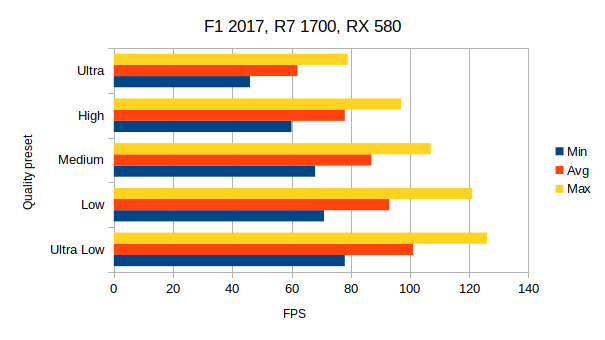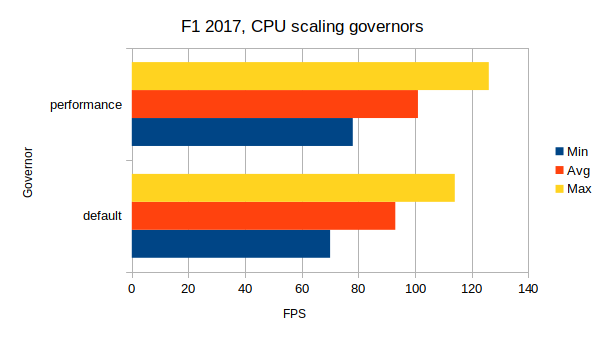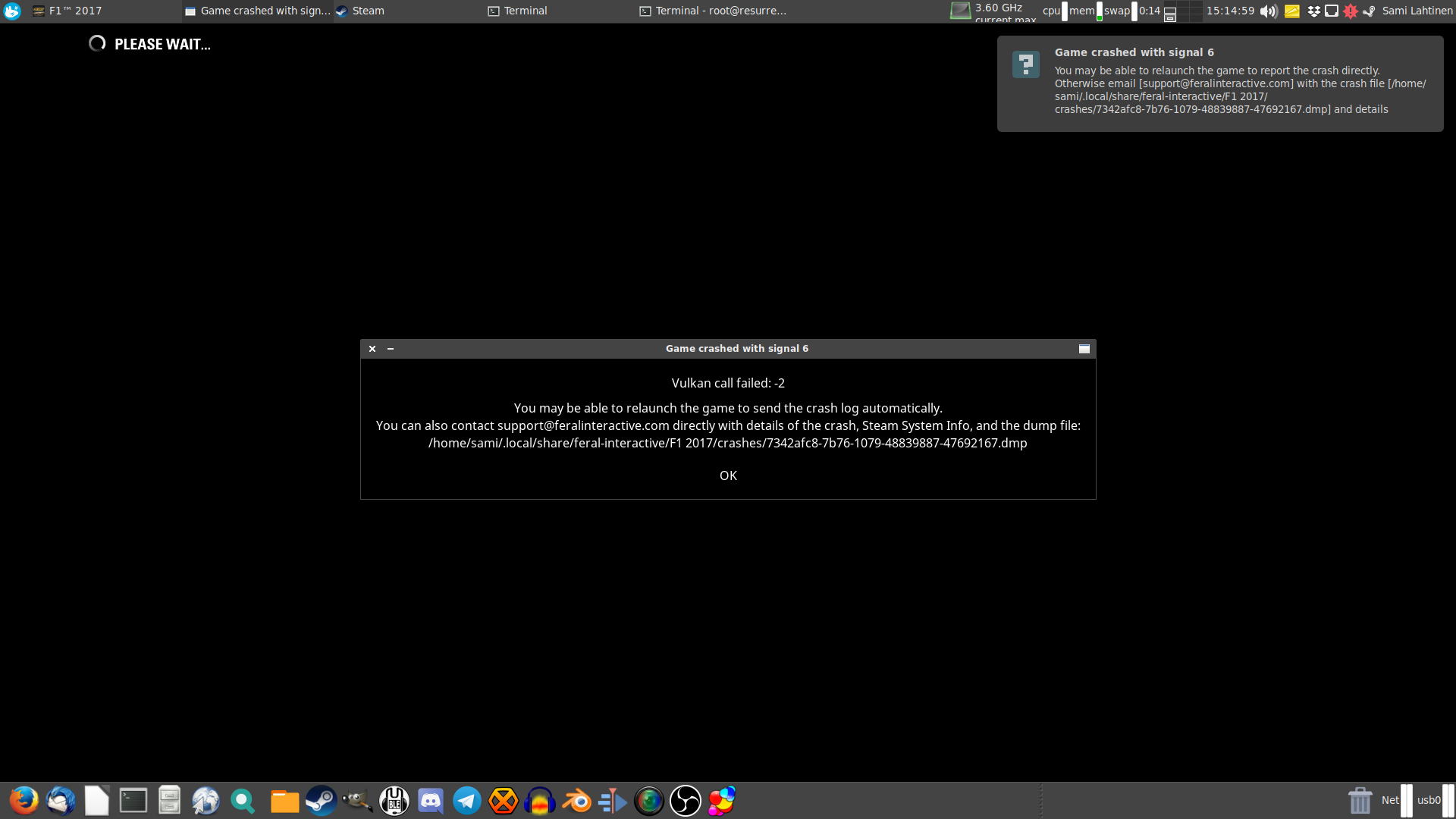You have likely read Liam’s thoughts and port review of F1 2017. I am going to complement his work by bringing you some numbers from the AMD side of things with my RX 580 and R7 370. So, hold onto your hats for we are benchmarking now!
Before we dive into the numbers let’s take a look at the system requirements and the hardware we will be testing the game on. The game expects an Intel Core i3-3225 3.3GHz processor minimum and recommends an Intel Core i5-6600K processor. RAM requirements are a minimum of 4GB and a recommended 8GB and for the GPU the game wants a 3rd generation AMD GCN GPU or a GTX 680 2GB minimum and recommends a GTX 1070. To open that “3rd Gen AMD GCN GPU” thing up a bit, that specifically means the R9 285, R9 380, R9 380X and the Fury cards. AMD VEGA is not supported but the Polaris cards (4xx and 5xx series) presumably are. For AMD the Mesa 17.2.2 version is required.
I will be testing the game on my main gaming rig, which has a Ryzen R7 1700 @ 3.7GHz, 16GB of 2133MHz RAM and an Asus ROG Strix RX 580 8GB GPU. I will also quickly touch on the GCN 1.0 support with the older Asus Strix R7 370 card. All testing was done on Arch (Antergos) using kernel 4.13.9 and Mesa 17.2.4. The CPU scaling governor was set to “performance” as recommended by Feral Interactive.
For the sake of simplicity testing was limited to 1080p resolution without anti-aliasing and/or anisotropic filtering. The numbers were acquired using the built-in benchmark with the default settings. Note that the built-in benchmark is not 100% accurate and changes slightly from one run to another.
The benchmark yielded the following numbers:

As you can see, the game does not scale all that much going from the Ultra Low preset to the Medium preset. The framerates do change a bit but the difference is not particularly huge. The largest performance drop comes from switching the graphics preset from High to Ultra at which point the minimum framerate dropped below 60 FPS for the first time. However, as far as I am concerned the game was still fully playable even on Ultra settings and maintained an average framerate of about 60 FPS. If you asked me, Feral could have put the RX 580 in the recommended GPU section without any complaints.
During benchmarking I also monitored CPU utilization via htop to see how much CPU horsepower the game was utilizing. The CPU usage was at its highest during the Ultra Low benchmark run and utilized up to 4 cores worth of CPU time. When the quality preset was increased the game began utilizing less and less CPU, presumably because of an increasing GPU bottleneck. On Ultra settings the game was only taking advantage of around 3 cores. The takeaway here is that games like F1 2017 can take advantage of up to 4 CPU cores, so owners of dual-core and quad-core CPUs might want to start considering moving to CPUs with higher core counts, particularly if they intend to run more demanding background tasks, such as streaming software, while gaming.
I also decided to take a look at how big of a difference the CPU scaling governor made, since I was initially feeling a bit lazy about switching the CPU to performance mode. The Ultra Low graphics preset was used here to emphasize the load on the CPU. The difference was as follows:

As you can see, switching from the default CPU scaling governor to “performance” yielded a tangible performance boost. The minimum framerate improved from 70 FPS to 78 FPS and the averages jumped from 93 FPS to 101 FPS. While these numbers might be somewhat insignificant on a 60Hz screen, they will be quite visible on high refresh-rate monitors and in addition give a little bit of extra headroom for potential frame drops. The game was fully playable even without setting the “performance” governor though, so if you are indeed feeling lazy about changing governors you can safely ignore it and still get a decent gaming experience.
Finally, I decided to take a look at the game on a GPU that is well below the hardware requirements, namely the Strix R7 370. Despite being a 300-series card the R7 370 is actually a first-generation GCN card, essentially a rebrand of the R9 270 which itself was a rebrand of the HD 7850. This card by default does not even have a functioning Vulkan driver, since AMDGPU is required for RADV to work. I manually enabled AMDGPU GCN 1.0 support and tried the game. It did start but when I started the benchmark I was greeted with the following message:

So yeah, apparently GCN 1.0 support in AMDGPU is still in such an experimental state that F1 2017 refuses to work properly. That doesn’t surprise me much, since the only Vulkan game I’ve managed to get working on the GPU is vkQuake. If you have a GCN 1.0 card like the R7 370, I would say don’t even bother with F1 2017. Just to reiterate, F1 2017 only uses Vulkan and there is no OpenGL backend.
So, all in all, if you have a system that falls within the recommended system specifications, F1 2017 runs quite fine and considering how well the game runs on my RX 580, I have no doubt the game would be playable on the slower 3rd generation GCN cards, such as the R9 285. Just make sure your GPU is actually one of the supported GPUs, since the GCN 1.0 and 1.1 (2nd generation) cards can have Vulkan driver issues that prevent you from playing the game entirely.
Any help?
It looks like I could run this game with a decent frame rate on my RX 480. Since it's not my type of game I might just skip it this time.
Quoting: pete910@samsai get that ram 3000 + preferably 3200. You are losing 40% ish of perf with that ram @ 2133The kit I own does not go beyond 2133, so that's where it will stay. Plus, I highly doubt that 40% figure, considering the performance would have to scale almost perfectly with memory speed, which is only possible in situations where you are only stressing the memory and nothing else. Going by figures online, my prediction would be around 10-20% improvement in some games and below 10% in productivity. At the current DDR4 prices I am not going to be replacing my 16GB kit with faster memory for those kinds of figures.
Quoting: SamsaiQuoting: pete910@samsai get that ram 3000 + preferably 3200. You are losing 40% ish of perf with that ram @ 2133The kit I own does not go beyond 2133, so that's where it will stay. Plus, I highly doubt that 40% figure, considering the performance would have to scale almost perfectly with memory speed, which is only possible in situations where you are only stressing the memory and nothing else. Going by figures online, my prediction would be around 10-20% improvement in some games and below 10% in productivity. At the current DDR4 prices I am not going to be replacing my 16GB kit with faster memory for those kinds of figures.
Not done your homework have you :P
The Mem speed is tied in to the inter CCX of the ryzen arch. thus why a big diff can be had.
View video on youtube.com This gives you one example, all be it on windows. There is countless others too
But yes mem prices are ludicrous ATM.
Quoting: pete910I am aware of the effect memory speed has on inter-CCX communications and the examples you provided align with my prediction of 10-20% improvement, varying from game to game. None of the games shown in that video had scaling up to 40%. Plus, those benchmarks were run with the CPU clocked at 4GHz, whereas my CPU is clocked at a peak of 3.7GHz, meaning that memory speed differences become even more pronounced.Quoting: SamsaiQuoting: pete910@samsai get that ram 3000 + preferably 3200. You are losing 40% ish of perf with that ram @ 2133The kit I own does not go beyond 2133, so that's where it will stay. Plus, I highly doubt that 40% figure, considering the performance would have to scale almost perfectly with memory speed, which is only possible in situations where you are only stressing the memory and nothing else. Going by figures online, my prediction would be around 10-20% improvement in some games and below 10% in productivity. At the current DDR4 prices I am not going to be replacing my 16GB kit with faster memory for those kinds of figures.
Not done your homework have you :P
The Mem speed is tied in to the inter CCX of the ryzen arch. thus why a big diff can be had.
View video on youtube.com This gives you one example, all be it on windows. There is countless others too
But yes mem prices are ludicrous ATM.
Quoting: SamsaiQuoting: pete910I am aware of the effect memory speed has on inter-CCX communications and the examples you provided align with my prediction of 10-20% improvement, varying from game to game. None of the games shown in that video had scaling up to 40%. Plus, those benchmarks were run with the CPU clocked at 4GHz, whereas my CPU is clocked at a peak of 3.7GHz, meaning that memory speed differences become even more pronounced.Quoting: SamsaiQuoting: pete910@samsai get that ram 3000 + preferably 3200. You are losing 40% ish of perf with that ram @ 2133The kit I own does not go beyond 2133, so that's where it will stay. Plus, I highly doubt that 40% figure, considering the performance would have to scale almost perfectly with memory speed, which is only possible in situations where you are only stressing the memory and nothing else. Going by figures online, my prediction would be around 10-20% improvement in some games and below 10% in productivity. At the current DDR4 prices I am not going to be replacing my 16GB kit with faster memory for those kinds of figures.
Not done your homework have you :P
The Mem speed is tied in to the inter CCX of the ryzen arch. thus why a big diff can be had.
View video on youtube.com This gives you one example, all be it on windows. There is countless others too
But yes mem prices are ludicrous ATM.
I admit 40% is best case, But yes alot are at stock like yours is at. What I was getting at is that it's not just games that benefit from it. As for your predictions, well
As is evident, pretty much 40%. again best case but still. You see my point.
Last edited by pete910 on 6 November 2017 at 7:39 pm UTC
Quoting: LeopardSo Linux in general , can't recognize performance needed workloads and because of that you have to adjust that on your own.
Well, it can. But when it comes to high performance gaming, the performance simply doesn't increase fast enough to maintain the wanted framerate. So what the performance governor does is to simply run the CPU at maximum at all times, which is pretty much what Windows does too most of the time - except on laptops running on battery in powersaver mode.
If you wish to have maximum performance at all times, and don't mind the extra fan noise or battery drain on laptops, just leave the governor on performance. The governor can be changed with a single command too, which in most cases is far easier than the control panel mayhem in windows. ;)
But yeah, wouldn't hurt if some of the linux desktops (at least the big ones like Gnome which surely has enough smart brains and manpower to create it) added some feature that could detect fullscreen 3d applications and bump up the governor at those times. It might be that wayland is required to properly detect fullscreen applications of that kind, but Gnome ran wayland last I checked. :)
Quoting: Fenix2412truth, but when i think about "AMD And vulkan" i remember of Doom where AMD got an incredible boost And the fury cards beated 1080 that why i was supposing the possibility of a 580 beating or matching a 980ti, maybe i was hoping too much expecting something like that or something near Windows.Quoting: veccherseems to work fine, but i was expecting something a little better since it's "AMD and Vulkan", still behind the 980ti, also seems to be far behind windows sadly, but at least it's good to see that it works at 60fps ultra/full HD even with a computer that isn't extremely expensive.A GTX 980Ti is a faster card than an RX 580 so it's rather obvious that an RX 580 would be slower.






See more from me